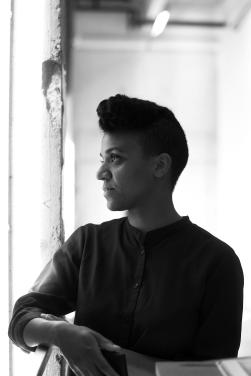
Kapwani Kiwanga (b. Hamilton, Canada) is French and Canadian. She graduated with a BA in Anthropology & Comparative Religion from McGill University, Montreal, in 2002, from La Seine research program at the École Nationale des Beaux-Arts de Paris in 2007, and Le Fresnoy–Studio National des Arts Contemporains, Tourcoing, in 2009. She was awarded the Swiss Zurich Art Prize in 2022, the French Marcel Duchamp Prize in 2020, and the Canadian Sobey Art Award in 2018. Kapwani Kiwanga is represented by Goodman Gallery, Cape Town, Johannesburg, and London; Galerie Poggi, Paris; and Galerie Tanja Wagner, Berlin.
Kapwani Kiwanga’s work often manifests as installations, sound, video, and performance. She intentionally confuses truth and fiction in order to unsettle hegemonic narratives and create spaces in which marginal discourse can flourish. As a trained anthropologist and social scientist, she occupies the role of a researcher in her projects. Her methodology includes fashioning systems and establishing protocols as in scientific experimentation to delineate lenses through which one can observe culture and it’s characteristic propensity toward mutation. Afrofuturism, anti-colonial struggle and it’s memory, belief systems, vernacular and popular culture are but some of the research areas which inspire her practice.
Glow #11, 2020
Sahara Noir Marble, wood, LEDs, Plexiglas
180 x 86 x 61
Courtesy: Galerie Tanja Wagner and Kapwani Kiwanga
Jalousie, 2018
Steel, two-way mirror
220 x 320 x 10 cm
Courtesy: Galerie Tanja Wagner and Kapwani Kiwanga
In March 1713, the Common Council of the City of New York, approved ‘A Law for Regulating Negro & Indian Slaves in the Night Time’. This law required any enslaved person above fourteen years of age to carry a lantern or lighted candle when outside after dusk. Though slavery has now long since been abolished, the New York Police Department still uses high-intensity artificial lights to surveil housing projects, using violent illumination as a biopolitical tool. Artist Kapwani Kiwanga examines the matrix of the white gaze and its persecutory mechanisms, as a regime of surveillance that produces and reproduces race as an index of vulnerability to state or state sanctioned violence. In all three works on display, Kiwanga refers to the asymmetry between those who see and those who are seen, and, albeit obliquely, to the hidden racial dimension of the synoptic gaze – thematising black fugitivity as an attempt to evade capture.
Novaya Zemlya, 2015-2023
Audio and slideshow projection
13'23"
Courtesy: Kapwani Kiwanga
The Novaya Zemlya effect is an optical illusion caused by the refraction of sunlight between atmospheric thermal layers. This effect induces one to think the Sun rose earlier than it should have, and at times can serve to flatten the Sun into a line or square. The first person to record the Novaya Zemlya mirage was Gerrit de Veer, a member of the ill-fated expedition led by Willem Barentsz, who was searching for a Northeast passage that would allow the Dutch direct access to China, after the conquest of Constantinople, captured by the Ottoman Empire, closed off the silk roads. The aim of the expedition was to find a passage through the Arctic, but its premise was the mistaken belief that sea water could not freeze. Trapped by the ice on the archipelago of Novaya Zemlya, the Barentz crew were forced to spend the winter in a makeshift lodge. This house, artist Kapwani Kiwanga tells us, was sealed hermetically from time by a thick layer of ice. On January 24, 1597, de Veer saw the Sun appear above the horizon, approximately two weeks prior to its calculated return. His claim was met with disbelief among scientists, who thought that he had simply been unable to keep an accurate record of time during the long polar nights. De Veer retorted: “the Sun may lie but my clock does not”—holding the accuracy of measuring instruments in such regard as to belittle human eyes. In July 1954, Novaya Zemlya was designated as a nuclear weapons testing venue, and in 1961 the most powerful nuclear weapon ever detonated was tested at the site. Narrated by the artist herself, Novaya Zemlya removes the history of scientific discoveries from their pristine analytic lineage in order to ground it at sites of imperial extraction or expansion.